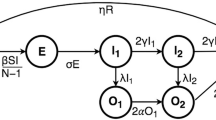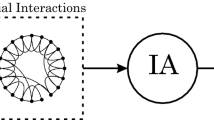Abstract
HIV/AIDS in the Sub-Saharan Africa is one of the biggest threats against sustainable human development in the region. One of the implications of this epidemic is that it not only affects individuals and their households but also increases burden on traditional social and support networks or safety nets. Research reported in recent years, have indicated on the possibility of weakening and even breaking of these support networks. In this paper, we suggest that by analyzing dynamical networks generated from agent-based simulations, one could describe this effect with better precision. This idea is based upon our previous work, which attempts at finding techniques to identify structural changes in dynamic networks.
Access this chapter
Tax calculation will be finalised at checkout
Purchases are for personal use only
Preview
Unable to display preview. Download preview PDF.
Similar content being viewed by others
References
Alam, S.J., Meyer, R., Ziervogel, G.,& Moss, S. (2007a). The Impact of HIV/AIDS in the Context of Socioeconomic Stressors: An Evidence-driven Approach. Journal of Artificial Societies and Social Simulation, 10(4) <http://jasss.soc.surrey.ac.uk/10/4/7.html>.
Alam, S.J., Edmonds, B.,& Meyer, R. (2007b). Identifying Structural Changes in Networks Generated from Agent-based Social Simulation Models. In Proceedings of Tenth Pacific RIM Intl Workshop on Multi-Agents (PRIMA’07), Bangkok, Thailand.
Albert, R. & Barabasi, A. (2002). Statistical Mechanics of Complex Networks. Rev. Mod. Phys., 74.
Asur, S., Parthasarathy, S.,& Ucar, D. (2007). An Event-based Framework for Characterizing the Evolutionary Behavior of Interaction Graphs. In Proceedings of the Thirteenth Conf. on Knowledge Discovery and Data Mining, San Jose, USA.
Burk, W.J., Steglich, C.E.G.,& Snijders, T.A.B. (2007). Beyond dyadic interdependence Actororiented models for co-evolving social networks and individual behaviors. International Journal of Behavioral Development, 31, 397–404.
Carley, K.M. (2003). Dynamic Network Analysis, in Dynamic Social Network Modeling and Analysis: Workshop Summary and Papers. Breiger et al. (Eds.) Washington, DC. 133–145.
Falkowski, T., Bartelheimer, J.,& Spiliopoulou, M. (2006). Mining and Visualizing the Evolution of Subgroups in Social Networks. In Proceedings of the International Conference on Web Intelligence (WI’06). IEEE Press. 52–58.
Foster, G. (2005). Under the Radar-Community Safety Nets for Children Affected by HIV/AIDS in Poor Households in Sub-Saharan Africa. United Nations Research Institute for Social Development (UNRISD).
Faust, K. (2006). Comparing Social Networks: Size, Density, and Local Structure. Metodološki zveski, 3(2), 185–216.
Gillespie, S., Kadiyala, S.,& Greener, R. (2007). Is poverty or wealth driving HIV transmission? AIDS. 21Suppl 7, 5–16.
Heuveline, P. (2004). Impact of the HIV epidemic on population and household structure: the dynamics and evidence to date. AIDS. 18(suppl. 2). 45–53.
Kirman, T.W. (1998). Statistics to Use, http://www.physics.csbsju.edu/stats/.
Kossinets, G., & Watts, D.J. (2006). Empirical analysis of an evolving social network. Science, 311, 88–90.
Krackhardt, D. (1987). QAP Partialling as a Test of Spuriousness. Social Networks. 9. 171–186
Moss, S., & Edmonds, B. (2005). Sociology and Simulation: Statistical and Qualitative Cross-Validation. American Journal of Sociology, 110(4), 1095–1131.
Mturi, A, Xaba, T.,& Sekokotla, D. (2003). Assessment of circumstances facing contemporary families in South Africa. Durban: School of Development Studies, University of Natal.
Neave, H., & McConwa, K. (1987). Distribution free methods. Open University Press.
Press, W.H., Flannery, B.P., Teukolsky, S.A., & Vetterling, W.T. (1992). Numerical Recipes in C: The Art of Scientific Computing. 2nd Ed. Cambridge: Cambridge University Press.
Pronyk, P. (2002). Social Capital and the HIV/AIDS epidemic in rural South Africa: The New Magic Bullet? The Department of Infectious and Tropical Diseases, The London School of Hygiene & Tropical Medicine, London. <http://www.wits.ac.za/radar/PDF%20files/socialcapital_HIV.PDF>.
Snijders, T.A.B, Steglich, C.E.G.,& Schweinberger, M. (2007). Modeling the co-evolution of networks and behaviour. In van Montford et al. (Eds.), Longitudinal models in behavioral and related sciences (pp. 41–71).
Ziervogel, G., et al. (2006). Adapting to climate, water and health stresses: insights from Sekhukhune, South Africa. Stockholm Environment Institute (Oxford).
Author information
Authors and Affiliations
Editor information
Rights and permissions
Copyright information
© 2008 VS Verlag für Sozialwissenschaften | GWV Fachverlage GmbH, Wiesbaden
About this chapter
Cite this chapter
Alam, S.J., Meyer, R. (2008). Structural Changes in Agent-Based Simulations: Representing HIV/AIDS Impact on Social Networks. In: Friemel, T.N. (eds) Why Context Matters. VS Verlag für Sozialwissenschaften. https://doi.org/10.1007/978-3-531-91184-7_9
Download citation
DOI: https://doi.org/10.1007/978-3-531-91184-7_9
Publisher Name: VS Verlag für Sozialwissenschaften
Print ISBN: 978-3-531-16328-4
Online ISBN: 978-3-531-91184-7
eBook Packages: Humanities, Social Sciences and LawSocial Sciences (R0)




